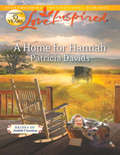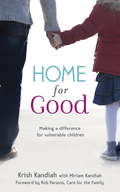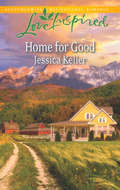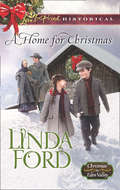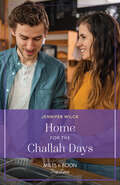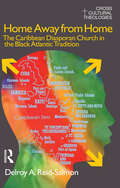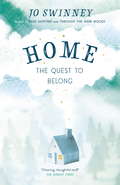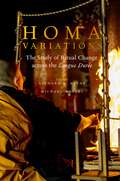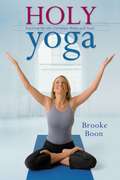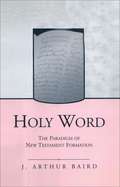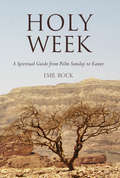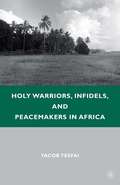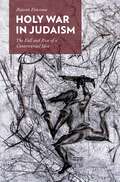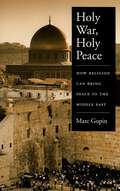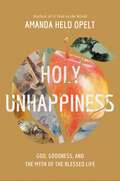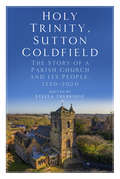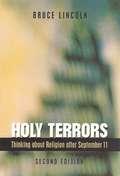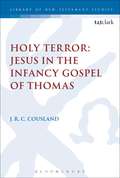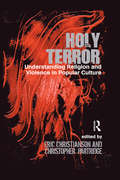- Table View
- List View
Home for Good: Making a Difference for Vulnerable Children
by Krish KandiahTying in to a nationwide joint campaign by the Evangelical Alliance and Care for the Family, Krish Kandiah wants us all to take seriously Jesus's call to 'suffer the little children' by engaging with the needs of the many thousands of children up and down the country who are in care and whom the church could and should be helping.Krish and his wife Miriam have adopted and fostered children themselves and their experience - and that of the many others in this book - is very different from the popular myth which suggests social services seek to prevent Christians from getting involved. Krish argues that whatever the state's stance may be, it is a part of our calling as God's church to get involved where it's hardest, and to help these children out of the tough realities they find themselves in.Filled with stories from people who have adopted or were adopted themselves, alongside practical advice on how it all works and the challenges that will come, this book makes a compelling case that the church can and must make a difference in these children's lives, and asks us all to consider our response.
Home for Good (Mills And Boon Love Inspired Ser.)
by Jessica Keller“I MADE A PROMISE TO PROTECT YOU.” But pregnant Ali Silver’s husband broke his vow and walked away from her. After being injured in combat, Jericho has finally come home to Bitterroot Valley to make peace with his father and regain Ali’s trust. But the single mom’s keeping secrets of her own.
A Home For Christmas: A Home For Christmas The Holiday Courtship A Convenient Christmas Bride Her Longed-for Family (Christmas in Eden Valley #3)
by Linda FordThe Cowboy's Family
Home For The Challah Days (Holidays, Heart and Chutzpah #1)
by Jennifer WilckTurning the bitterness of the past… Into a sweet future!
Home Away from Home: The Caribbean Diasporan Church in the Black Atlantic Tradition
by Delroy A. Reid-SalmonAn estimated two-thirds of Caribbeans live outside their homeland. 'Home Away from Home' identifies the different forms of Caribbean diasporan identity and argues that the faith Caribbean people brought with them into the diaspora plays a central role in their development. The study provides a theological interpretation of the diasporan experience, and outlines the principles of diasporan theology and the distinctiveness of its church. Focusing on the Caribbean diaspora in the US, and analysing aspects of the Caribbean British diaspora, the book forges a Black Atlantic theology. The volume also engages with wider discourse on the Black diaspora to offer an inclusive Caribbean diasporan ecclesiology that overcomes Black African-American/Euro-American binaries.
Home Away from Home: The Caribbean Diasporan Church in the Black Atlantic Tradition (Cross Cultural Theologies Ser.)
by Delroy A. Reid-SalmonAn estimated two-thirds of Caribbeans live outside their homeland. 'Home Away from Home' identifies the different forms of Caribbean diasporan identity and argues that the faith Caribbean people brought with them into the diaspora plays a central role in their development. The study provides a theological interpretation of the diasporan experience, and outlines the principles of diasporan theology and the distinctiveness of its church. Focusing on the Caribbean diaspora in the US, and analysing aspects of the Caribbean British diaspora, the book forges a Black Atlantic theology. The volume also engages with wider discourse on the Black diaspora to offer an inclusive Caribbean diasporan ecclesiology that overcomes Black African-American/Euro-American binaries.
Home: the quest to belong
by Jo SwinneyWhere is Home?This question troubles many of us. We may live far from where we grew up, away from those we love or in a culture not our own. But we all need somewhere to belong, to find a sense of home in this world.Jo Swinney was born in the UK, but grew up in Portugal and France. She went to an English boarding school, did a gap year in southern Africa and in her twenties studied theology in Canada, where she met her American husband. Now back in the UK, she's had more reason than most to wonder what 'home' really means.Is home where you come from - where you live now - where the people you love are - or what?Interweaving a frank and poignant retelling of her own story with theological and psychological insights, Jo's original and authentic exploration of home in all its many and varied forms is a heartfelt call to find our home in the things that are truly of most value.
Homa Variations: The Study of Ritual Change across the Longue Durée (Oxford Ritual Studies)
Found in many different religious cultures, the practice of making votive offerings into fire dates back to the earliest periods of human history. Throughout the tantric world, this kind of ritual offering practice is known as the homa. With roots in Vedic and Zoroastrian rituals, the tantric homa was formed in early medieval India. Since that time tantric Buddhist practitioners transmitted it to East and Central Asia, and more recently to Europe and the Americas. Today, Hindu forms of the homa are being practiced outside of India as well. Despite this historical and cultural range, the homa retains an identifiable unity of symbolism and ritual form. Homa Variations is the first volume to provide a series of detailed studies of a variety of homa forms. This collection of essays provides an understanding of the history of the homa from its inception up to its use in the present. The book also covers homa practice throughout a wide range of religious cultures, from India and Nepal to Tibet, China, and Japan. The theoretical focus of the collection is the study of ritual change over long periods of time, and across the boundaries of religious cultures. The identifiable unity of the homa allows for an almost unique opportunity to examine ritual change with such a broad perspective.
Holy Yoga: Exercise. for the Christian Body and Soul
by Brooke BoonPeople often equate yoga withEastern religion, but Brooke Boonsees it as an exercise style thatChristians can use to generate patience,strength, and deeper worship.Author and yoga instructorBrooke Boon combines her passionfor Christianity with her commitmentto health to introduce yoga asa physical and spiritual disciplinethat strengthens the body and thesoul. Clear explanations and photographsmake yoga accessible forany reader, and Brooke offers customizedroutines for readers strugglingwith specific issues, such asweight loss and anxiety. Through it all Brooke uses scripturalreferences to help reinforce the idea that by takingcare of our bodies we can also take care of our faith.
Holy Word: The Paradigm of New Testament Formation (The Library of New Testament Studies #224)
by J. Arthur BairdJ. Arthur Baird is the author of several important books in New Testament studies, his best known perhaps being his Audience Criticism and the Historical Jesus. At his untimely death, he left a nearly complete manuscript, now published here. In this timely and relevant manuscript, Baird offers first a critical introduction to the historical paradigm, pointing out its limitations in terms of tracing the paradigm of New Testament formation. He then traces this development himself, beginning with the starting point of the Holy Word and noting its development through the context, theological interpretation, and application, to its manifestation in the apostles, schools and fathers. He concludes with comments on its current implications. This book represents the last and lasting final thoughts of a scholar who was very much devoted to the importance of the Holy Word.
Holy Week: A Spiritual Guide from Palm Sunday to Easter
by Emil BockEaster Holy Week is a unique time in the Christian calendar, containing both dramatic lows and highs, as well as time for reflection and meditation.This lovely little book offers readers an inspiring guide from Palm Sunday to Easter Sunday. It vividly brings the events of Holy Week alive, enabling us to follow the mystery drama of the Passion.It also provides opportunities for prayer and contemplation, with each day accompanied by the gospel reading which the author describes.
Holy Warriors, Infidels, and Peacemakers in Africa
by Y. TesfaiOut of the many challenges facing Africa today, there is the tendency of some to manipulate religious and ethnic identities for private interests. The book examines how religion has given rise to these conditions in Africa, by weaving together issues of poverty, wealth, and violent conflicts.
Holy War in Judaism: The Fall and Rise of a Controversial Idea
by Reuven FirestoneHoly war, sanctioned or even commanded by God, is a common and recurring theme in the Hebrew Bible. Rabbinic Judaism, however, largely avoided discussion of holy war in the Talmud and related literatures for the simple reason that it became dangerous and self-destructive. Reuven Firestone's Holy War in Judaism is the first book to consider how the concept of ''holy war'' disappeared from Jewish thought for almost 2000 years, only to reemerge with renewed vigor in modern times. The revival of the holy war idea occurred with the rise of Zionism. As the necessity of organized Jewish engagement in military actions developed, Orthodox Jews faced a dilemma. There was great need for all to engage in combat for the survival of the infant state of Israel, but the Talmudic rabbis had virtually eliminated divine authorization for Jews to fight in Jewish armies. Once the notion of divinely sanctioned warring was revived, it became available to Jews who considered that the historical context justified more aggressive forms of warring. Among some Jews, divinely authorized war became associated not only with defense but also with a renewed kibbush or conquest, a term that became central to the discourse regarding war and peace and the lands conquered by the state of Israel in 1967. By the early 1980's, the rhetoric of holy war had entered the general political discourse of modern Israel. In Holy War in Judaism, Firestone identifies, analyzes, and explains the historical, conceptual, and intellectual processes that revived holy war ideas in modern Judaism.
Holy War in Judaism: The Fall and Rise of a Controversial Idea
by Reuven FirestoneHoly war, sanctioned or even commanded by God, is a common and recurring theme in the Hebrew Bible. Rabbinic Judaism, however, largely avoided discussion of holy war in the Talmud and related literatures for the simple reason that it became dangerous and self-destructive. Reuven Firestone's Holy War in Judaism is the first book to consider how the concept of ''holy war'' disappeared from Jewish thought for almost 2000 years, only to reemerge with renewed vigor in modern times. The revival of the holy war idea occurred with the rise of Zionism. As the necessity of organized Jewish engagement in military actions developed, Orthodox Jews faced a dilemma. There was great need for all to engage in combat for the survival of the infant state of Israel, but the Talmudic rabbis had virtually eliminated divine authorization for Jews to fight in Jewish armies. Once the notion of divinely sanctioned warring was revived, it became available to Jews who considered that the historical context justified more aggressive forms of warring. Among some Jews, divinely authorized war became associated not only with defense but also with a renewed kibbush or conquest, a term that became central to the discourse regarding war and peace and the lands conquered by the state of Israel in 1967. By the early 1980's, the rhetoric of holy war had entered the general political discourse of modern Israel. In Holy War in Judaism, Firestone identifies, analyzes, and explains the historical, conceptual, and intellectual processes that revived holy war ideas in modern Judaism.
Holy War, Holy Peace: How Religion Can Bring Peace to the Middle East
by Marc GopinThe Intifada of 2000-2001 has demonstrated the end of an era of diplomacy in the Arab-Israeli conflict. The style of peacemaking of the Olso Accords has been called into question by the facts on the ground. Elite forms of peacemaking that do not embrace the basic needs of average people on all sides are bound to fail. The complete neglect of deeper cultural and religious systems in the peace process is now apparent, as is the role that this neglect has played in the failure of the process. Building on his earlier book, Between Eden and Armageddon, Gopin provides a detailed blueprint of how the religious traditions in question can become a principal asset in the search for peace and justice. He demonstrates how religious people can be the critical missing link in peacemaking, and how the incorporation of their values and symbols can unleash a new dynamic that directly addresses basic issues of ethics, justice, and peace. Gopin's analysis of the theoretical, theological, and political planes shows us what has been achieved thus far, as well as what must be done next in order to ensure effective final settlement negotiations and secure, sovereign, democratic countries for both peoples.
Holy War, Holy Peace: How Religion Can Bring Peace to the Middle East
by Marc GopinThe Intifada of 2000-2001 has demonstrated the end of an era of diplomacy in the Arab-Israeli conflict. The style of peacemaking of the Olso Accords has been called into question by the facts on the ground. Elite forms of peacemaking that do not embrace the basic needs of average people on all sides are bound to fail. The complete neglect of deeper cultural and religious systems in the peace process is now apparent, as is the role that this neglect has played in the failure of the process. Building on his earlier book, Between Eden and Armageddon, Gopin provides a detailed blueprint of how the religious traditions in question can become a principal asset in the search for peace and justice. He demonstrates how religious people can be the critical missing link in peacemaking, and how the incorporation of their values and symbols can unleash a new dynamic that directly addresses basic issues of ethics, justice, and peace. Gopin's analysis of the theoretical, theological, and political planes shows us what has been achieved thus far, as well as what must be done next in order to ensure effective final settlement negotiations and secure, sovereign, democratic countries for both peoples.
Holy Unhappiness: God, Goodness, and the Myth of the Blessed Life
by Amanda Held OpeltDiscover what it means to be blessed and challenge the false beliefs many in the church hold about &“the good life&” and what it means to walk in communion with God. American Christians have developed a long list of expectations about what the life with God will feel like. Many Christians rightly deny the prosperity gospel—the idea that God wants you to be healthy and wealthy— but instead embrace its more subtle spin-off, the emotional prosperity gospel, or the belief that happiness and spiritual euphoria will inevitably follow if you believe all the right things and make all the right choices. In this view, frustration is deemed unholy, fear is seen as a failure of faith, and sadness is a sign of God&’s disfavor. In Holy Unhappiness, Amanda Held Opelt, author of A Hole in the World, grapples with her own experience of disillusionment when life with God didn&’t always feel the way she expected it to feel. She examines some of the historic, religious, and cultural influences that led to the idolization of positive feelings and the marginalization of negative feelings. Unpacking nine elements of life that have been tainted by the message of the emotional Prosperity Gospel – including work, marriage, parenting, calling, community, and church - she points to a new path forward, one that reimagines what the &“blessed&” life can be like if we release some of our expectations and seek God in places we never thought to look. This is a book that asks &“what good is God?&” when he doesn&’t always make sorrow go away or soothe every fear. It is a book that explores our aversion to sadness and counts the costs of our unrelenting commitment to optimism. This is a book that insists there is holiness to be found even in our unhappiness.
Holy Trinity, Sutton Coldfield: The Story of a Parish Church and its People, 1250-2020
by Stella ThebridgeFor the first time in its 750-year existence, a full history of Holy Trinity is available to the general public. One of only a small number of parish churches to be Grade I listed, Holy Trinity displays its rich heritage through stained glass, memorials, unique woodwork and glorious painted ceilings. It also houses the tomb of Sutton Coldfield’s most famous son, John Vesey, Bishop of Exeter, whose work for the benefit of both church and town, with the blessing of King Henry VIII, continues to earn him the respect of the local community in every generation. Funding from the Heritage Lottery Fund in 2017-19 has enabled this book to be researched and written. The timing of its publication enables the history to be as up-to-date as possible, following on from a major reordering of the church interior to create a space for church and community fit for the 21st century.
Holy Terrors, Second Edition: Thinking About Religion After September 11
by Bruce LincolnIt is tempting to regard the perpetrators of the September 11th terrorist attacks as evil incarnate. But their motives, as Bruce Lincoln’s acclaimed Holy Terrors makes clear, were profoundly and intensely religious. Thus what we need after the events of 9/11, Lincoln argues, is greater clarity about what we take religion to be. Holy Terrors begins with a gripping dissection of the instruction manual given to each of the 9/11 hijackers. In their evocation of passages from the Quran, we learn how the terrorists justified acts of destruction and mass murder “in the name of God, the most merciful, the most compassionate.” Lincoln then offers a provocative comparison of President Bush’s October 7, 2001 speech announcing U.S. military action in Afghanistan alongside the videotaped speech released by Osama bin Laden just a few hours later. As Lincoln authoritatively demonstrates, a close analysis of the rhetoric used by leaders as different as George W. Bush and Osama bin Laden—as well as Mohamed Atta and even Jerry Falwell—betrays startling similarities. These commonalities have considerable implications for our understanding of religion and its interrelationships with politics and culture in a postcolonial world, implications that Lincoln draws out with skill and sensitivity. With a chapter new to this edition, “Theses on Religion and Violence,” Holy Terrors remains one of the essential books on September 11 and a classic study on the character of religion. “Modernity has ended twice: in its Marxist form in 1989 Berlin, and in its liberal form on September 11, 2001. In order to understand such major historical changes we need both large-scale and focused analyses—a combination seldom to be found in one volume. But here Bruce Lincoln . . . has given us just such a mix of discrete and large-picture analysis.”—Stephen Healey, Christian Century “From time to time there appears a work . . . that serves to focus the wide-ranging, often contentious discussion of religion’s significance within broader cultural dynamics. Bruce Lincoln’s Holy Terrors is one such text. . . . Anyone still struggling toward a more nuanced comprehension of 9/11 would do well to spend time with this book.”—Theodore Pulcini, Middle East Journal
Holy Terrors, Second Edition: Thinking About Religion After September 11
by Bruce LincolnIt is tempting to regard the perpetrators of the September 11th terrorist attacks as evil incarnate. But their motives, as Bruce Lincoln’s acclaimed Holy Terrors makes clear, were profoundly and intensely religious. Thus what we need after the events of 9/11, Lincoln argues, is greater clarity about what we take religion to be. Holy Terrors begins with a gripping dissection of the instruction manual given to each of the 9/11 hijackers. In their evocation of passages from the Quran, we learn how the terrorists justified acts of destruction and mass murder “in the name of God, the most merciful, the most compassionate.” Lincoln then offers a provocative comparison of President Bush’s October 7, 2001 speech announcing U.S. military action in Afghanistan alongside the videotaped speech released by Osama bin Laden just a few hours later. As Lincoln authoritatively demonstrates, a close analysis of the rhetoric used by leaders as different as George W. Bush and Osama bin Laden—as well as Mohamed Atta and even Jerry Falwell—betrays startling similarities. These commonalities have considerable implications for our understanding of religion and its interrelationships with politics and culture in a postcolonial world, implications that Lincoln draws out with skill and sensitivity. With a chapter new to this edition, “Theses on Religion and Violence,” Holy Terrors remains one of the essential books on September 11 and a classic study on the character of religion. “Modernity has ended twice: in its Marxist form in 1989 Berlin, and in its liberal form on September 11, 2001. In order to understand such major historical changes we need both large-scale and focused analyses—a combination seldom to be found in one volume. But here Bruce Lincoln . . . has given us just such a mix of discrete and large-picture analysis.”—Stephen Healey, Christian Century “From time to time there appears a work . . . that serves to focus the wide-ranging, often contentious discussion of religion’s significance within broader cultural dynamics. Bruce Lincoln’s Holy Terrors is one such text. . . . Anyone still struggling toward a more nuanced comprehension of 9/11 would do well to spend time with this book.”—Theodore Pulcini, Middle East Journal
Holy Terror: Jesus in the Infancy Gospel of Thomas (The Library of New Testament Studies #560)
by J.R.C. CouslandThe Infancy Gospel of Thomas (or Paidika) is one of the most unusual gospels in the Christian tradition. Instead of revealing the compassionate Jesus so familiar to us from the biblical Gospels, it confronts its readers with a very different Jesus – a child who sometimes acts like a holy terror, killing and harming others for trifling faults. So why is Jesus portrayed as acting in such an 'unchristian' fashion? To address this question, Cousland focuses on three interconnected representations of Jesus in the Paidika: Jesus as holy terror, as child, and as miracle-working saviour. Cousland endeavours to show that, despite the differing character of these three roles, they present a unified picture. Jesus' unusual behaviour arises from his 'growing pains' as a developing child, who is at the same time both human and divine. Cousland's volume is the first detailed examination of the Christology of the Infancy Gospel of Thomas and provides a fresh and engaging approach to a topic not often discussed in representations of Jesus.
Holy Terror: Jesus in the Infancy Gospel of Thomas (The Library of New Testament Studies #560)
by J.R.C. CouslandThe Infancy Gospel of Thomas (or Paidika) is one of the most unusual gospels in the Christian tradition. Instead of revealing the compassionate Jesus so familiar to us from the biblical Gospels, it confronts its readers with a very different Jesus – a child who sometimes acts like a holy terror, killing and harming others for trifling faults. So why is Jesus portrayed as acting in such an 'unchristian' fashion? To address this question, Cousland focuses on three interconnected representations of Jesus in the Paidika: Jesus as holy terror, as child, and as miracle-working saviour. Cousland endeavours to show that, despite the differing character of these three roles, they present a unified picture. Jesus' unusual behaviour arises from his 'growing pains' as a developing child, who is at the same time both human and divine. Cousland's volume is the first detailed examination of the Christology of the Infancy Gospel of Thomas and provides a fresh and engaging approach to a topic not often discussed in representations of Jesus.
Holy Terror: Understanding Religion and Violence in Popular Culture
by Christopher Partridge Eric S. ChristiansonThe authors of religious scriptures had little difficulty enhancing sacred narratives with the rhetoric of violence. The phenomenon continues in the habitual linkage of violence and religion in contemporary film, music and literature. 'Holy Terror' brings together scholars of religious studies, biblical studies, film studies and sociology to examine the social function of violence in popular discourse. The book questions how violent rhetoric shapes belief and values, how audience empathy with violent protagonists can be understood, and the significance of the association of violence with particular religious groups and ideas. A range of phenomena are analysed, including terrorism in Scripture, apocalyptic texts in film and violence in sport.
